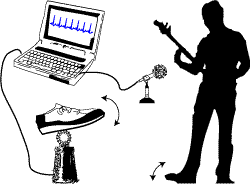|
|
Introduction |
Rhythm is one of the most basic ways that we understand and interact with time. Our first sensory impression as we float in our mother's womb is the rhythmic sound of her heart. The time between the opening and closing of the heart's valves is a clock that measures the passing of our lives. Breathing is our most lasting experience of rhythm.
Rhythms occur at all time scales. The motion of waves against a beach, the daily flow of the sun and moon, the waxing and waning of the year; these occur at rates much slower than the heartbeat. Pitched phenomenon such as the rotation of an engine, the oscillations of a string, and the vibrations of our vocal chords occur at rates much faster than the heartbeat. At the slowest rates, we conceive of the rhythm via long term memory. At rates near that of the heartbeat, we perceive the repetition directly as rhythm. At the fastest rates, the repetitions blur together into the perception called "pitch." Thus we perceive rhythmic patterns differently at different time scales.
Fig. 1 shows several seconds of the rhythmic beating of a healthy heart. Large spikes recur at approximately regular intervals and at approximately the same height. After each peak is a dip followed by two smaller bumps which vary slightly in position and size from beat to beat. This kind of regularity with variation, of repetition with change, is a characteristic feature of rhythmic patterns in time.

It is not easy to measure irregularities in the heartbeat by eye. The scraggly circular object in Fig. 1(b) contains the same heartbeat signal plotted so that time moves around the circle at a rate of approximately one heartbeat each cycle. This overlays the various beats, and the differences in the location of the peaks emphasizes the variability of the timing.
All animals engage in rhythmic motions: their hearts beat, they breathe, their brains exhibit periodic electrical activity, and they walk, run, or swim. Indeed, many such physical activities are easier to do rhythmically. It is almost impossible to walk without rhythm. The rhythms inherent in these behaviors are not direct responses to the environment, they are internally generated.
Though rhythms surround us in both the physical world and the animate world, humans are among the only creatures who create rhythmic patterns consciously. From the age of about 3-4 years, a child can tap along with a metronome or a song. This is significant not because of the regularity of the tapping but because of the synchrony: the child learns to recognize the regularity of the pulse and then anticipates successive pulses in order to tap at the same time. Most animals never develop this capability, suggesting that much of our experience of rhythm "comes from the mind, not from the body" . It is not easy to emulate this kind of synchronization in a computer, and Chapters 5 - 6 - 7 discuss the problem in depth. Perhaps our highest level of rhythmic achievement occurs in music, where rhythmic phenomena play in complex ways with our perceptions of time, sequence, and pattern.
A computational approach to the study of rhythm builds a model or a computer program that attempts to mimic people's behavior in locating rhythms and periodicities. Such a "foot-tapping machine" is diagrammed in Fig. 2. To the extent that the model can duplicate or imitate human behavior it can be judged successful. When it fails (as any model will eventually fail to capture the full range of human abilities), it helps identify the limits of our understanding.
